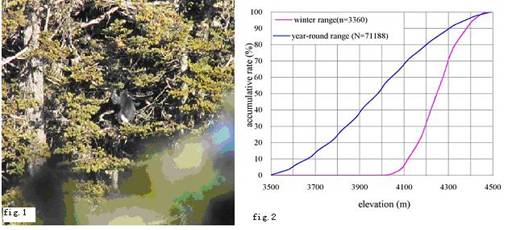In general, warm blood animals migrate from high altitude to low altitude areas to overwinter, while, for white-and-black snub-nosed monkeys (Rhinopithecus bieti), they prefer to choose the opposite direction. To explain this “abnormal” phenomenon, QUAN Ruichang (Xishuangbanna Tropical Botanical Garden (XTBG)-CAS), REN Guopeng (Kunming Institute of Zoology, CAS) and their colleges popped out the “sunshine hypothesis”.
In this study GIS technology was adopted to quantify solar radiation and sunshine duration across the monkey’s range in the mountainous region of the southeastern edge of the Tibetan Plateau and the results showed that: 1) R. bieti used the high altitude range between 4100–4400 m in winter although the yearly home range spanned from 3500–4500 m; 2) both solar radiation and sunshine duration increased with elevation while temperature decreased with elevation; 3) within the winter range, the use of range was significantly correlated with solar radiation and sunshine duration; 4) monkeys moved to the areas with high solar radiation and duration following a snowfall, where the snow melts faster and food is exposed earlier.These results enriched the previously invoked hypotheses to explain seasonal migration patterns in other species such as food abundance, temperature, and predators.
So far, the “sunshine hypothesis” is the first “sunshine” shines into the research field about winter space distribution of monkeys in temperate, high elevation areas. White-and-black snub-nosed monkeys are endangered species featured with the human-like red lips. This research highlighted the need for both theoretical and empirical studies to better understand the influence of sunshine on wildlife range distribution in the era of global climate change, which not only helps to protect the monkeys’ habitats, but also can be applied to other wildlife in this and other mountainous regions,
Most of the findings have been published on Plos One (http://dx.plos.org/10.1371/journal.pone.0024449).

Fig.1 R. bieti in the sunshine (by QUAN Ruichang).
Fig.2 The cumulative percentage of area for winter home range and year-round home range along with elevation (3501–4500 m) (by KIZ).
